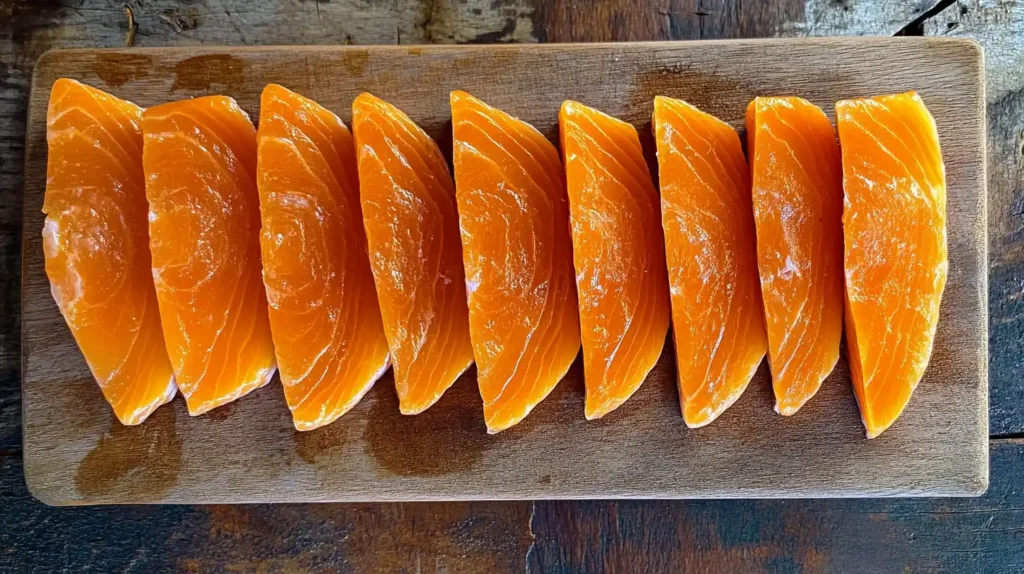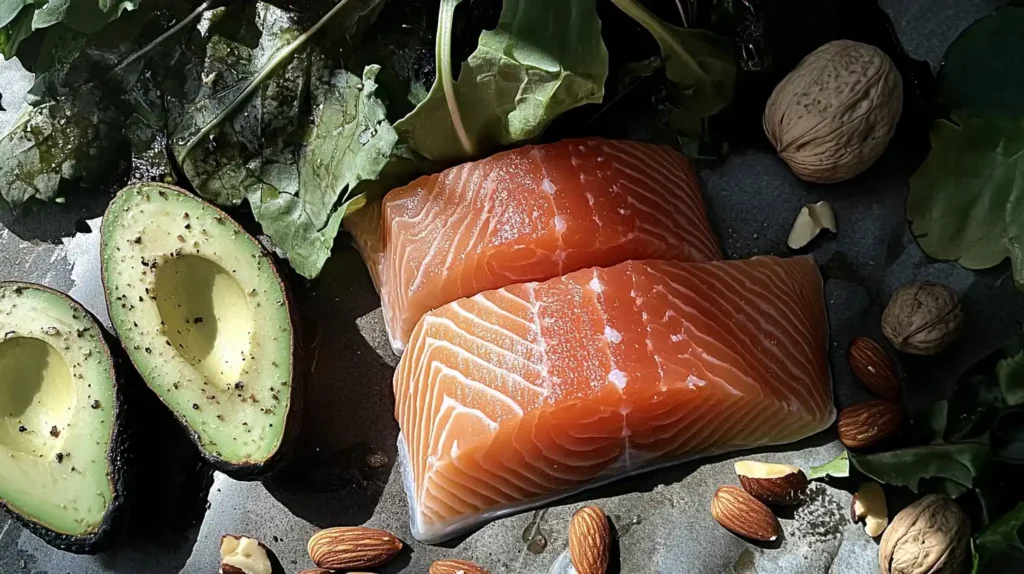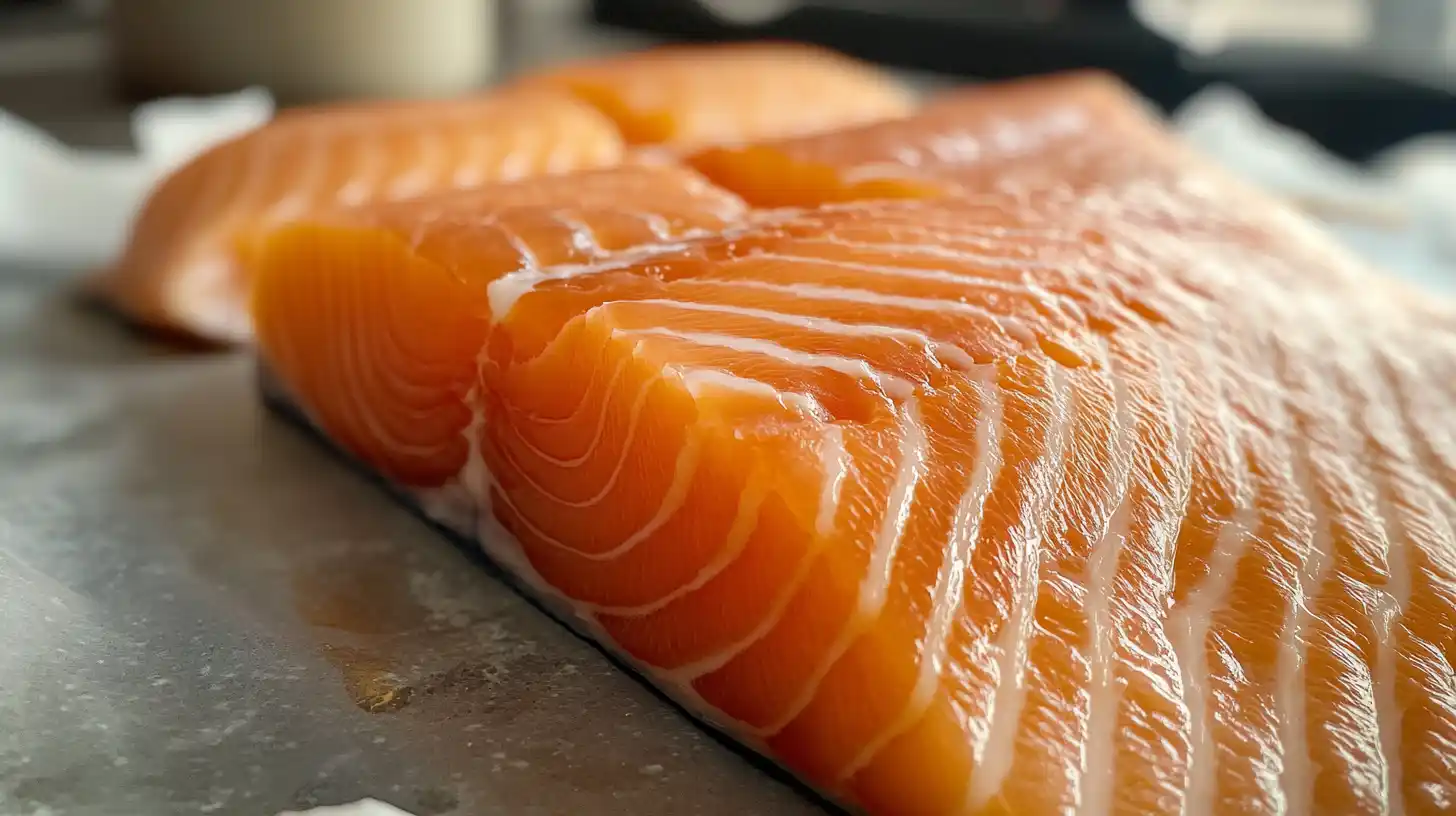Is salmon belly a good cut? Many seafood lovers believe it is one of the most flavorful and nutritious parts of the fish. Packed with healthy omega-3 fats, a buttery texture, and deep umami flavor, this cut is often used in sushi, grilling, and pan-searing. While some consider it a delicacy, others wonder if it is too fatty or difficult to cook.
In this guide, we’ll explore the benefits of salmon belly, its nutritional value, and why chefs love using it in various dishes. You’ll also learn the best ways to cook it to achieve the perfect balance of crispy and tender. If you enjoy seafood, this is a cut worth trying.
In this guide, we will explore:
- What makes salmon belly different from other cuts
- The health benefits of this fatty, delicious piece
- The best ways to cook and enjoy it
- Where to buy it and how to pick the best one
If you are a seafood lover or someone looking for a healthier cut, this article will help you decide whether salmon belly is right for you.

What is Salmon Belly? A Hidden Treasure in Seafood
Where Does Salmon Belly Come From?
Many people are familiar with salmon fillets, but few know about the belly cut. Salmon belly comes from the underside of the fish, running between the head and the tail. It is the richest, fattiest part of the salmon, which makes it incredibly soft, moist, and flavorful.
Unlike fillets, which are leaner and firmer, salmon belly has a smooth, buttery texture. The high-fat content makes it melt in your mouth, which is why it is prized in sushi and fine dining.
Why Is Salmon Belly Different from Other Salmon Cuts?
Here’s how salmon belly compares to other parts of the fish:
- Salmon Fillet – Leaner, firm, and easy to cook.
- Salmon Collar – Also fatty but has more bones.
- Salmon Tail – Less fatty, firmer, and good for grilling.
Many fishmongers remove the belly when preparing fillets, which makes it harder to find in stores. Because of this, many home cooks never get to try this amazing cut.
If you want to learn more about the health benefits of fatty fish, Explore further this omega-3 nutrition guide.
Health Benefits of Salmon Belly
Is salmon belly a good cut? Many seafood lovers believe it is one of the most flavorful and nutritious parts of the fish. Packed with healthy omega-3 fats, a buttery texture, and deep umami flavor, this cut is often used in sushi, grilling, and pan-searing. While some consider it a delicacy, others wonder if it is too fatty or difficult to cook.
But is salmon belly a good cut for everyday meals? This article will break down why this cut is special, comparing it to other parts of the fish and explaining its health benefits. You’ll also discover how to cook salmon belly for the best results, whether pan-seared, grilled, or enjoyed raw in sushi.
If you’ve ever asked, is salmon belly a good cut compared to fillets or other parts of the fish, this guide will answer all your questions. We’ll explore why chefs love it, what makes it unique, and how you can prepare it at home. Whether you’re looking for nutritional insights, cooking methods, or expert tips, you’ll find everything you need here.

1. Salmon Belly is Rich in Omega-3 Fatty Acids
One of the biggest reasons to eat salmon belly is its high omega-3 content. These healthy fats are essential for:
Heart health – Omega-3s help reduce bad cholesterol and lower blood pressure.
Brain function – They improve memory, focus, and mood.
Inflammation control – They help reduce joint pain and swelling.
Compared to regular fillets, salmon belly has a much higher concentration of omega-3s. This makes it one of the healthiest seafood choices available.
2. High-Quality Protein for Strong Muscles
Protein is essential for muscle growth, repair, and energy. The good news? Salmon belly is packed with high-quality protein that helps:
- Build and repair muscles and tissues.
- Keep you full longer, reducing hunger.
- Support healthy skin, hair, and nails.
Since salmon belly is also softer and juicier, it is easier to eat and digest compared to drier, leaner cuts.
3. Loaded with Vitamins and Minerals
Eating salmon belly means you’re also getting a powerful dose of essential vitamins and minerals. These include:
Vitamin D – Supports bone health and a strong immune system.
Vitamin B12 – Helps with energy production and brain health.
Selenium – An antioxidant that protects against cell damage.
Potassium – Helps maintain healthy blood pressure.
For more details, Dig deeper on why eating salmon belly is good for you?.
Why Salmon Belly is Loved by Chefs
Many professional chefs and seafood lovers consider salmon belly a delicacy. It is often served in high-end sushi restaurants and used in fine dining recipes. But what makes this cut so special?
1. Unmatched Flavor and Buttery Texture
One of the biggest reasons chefs love salmon belly is its rich, buttery taste. The high-fat content gives it a smooth, melt-in-your-mouth texture that you won’t find in leaner salmon cuts.
Intense umami flavor – The fat enhances the deep, rich taste of the fish.
Juicy and tender – Unlike regular fillets, it never feels dry.
Perfect balance of fat and protein – This makes it highly satisfying.
If you have never tried it before, imagine the smoothness of sushi-grade salmon but with even more flavor!
2. Versatile and Easy to Cook
Chefs love salmon belly because it can be cooked in many delicious ways. Whether you prefer raw, grilled, or pan-seared dishes, this cut adapts well to different flavors and cooking styles.
Here are some of the best ways to prepare salmon belly:
- Sashimi & Nigiri – Enjoyed raw in sushi for its delicate, fatty texture.
- Pan-seared – A crispy outside with a juicy, tender inside.
- Grilled or Broiled – High heat brings out the smoky flavor.
- Smoked or Cured – Preserving the fish enhances its deep, rich taste.
3. A More Sustainable Choice
Many people don’t realize that salmon belly is also a more sustainable option. Because fillets are more popular, fish processors often discard the belly to make uniform cuts. By eating salmon belly, you help reduce food waste and enjoy a cut that might otherwise go unused.

Downsides to Consider
Although salmon belly is delicious and nutritious, it may not be for everyone. Some people find it too fatty, while others struggle to cook it properly. Here are a few downsides to consider before buying salmon belly.
1. Higher Fat Content Can Be Greasy
While the high omega-3 content is great for health, some people don’t enjoy the extra fat. If it’s not cooked correctly, salmon belly can feel too oily or greasy.
Solution: Cook it using high heat (grilling, broiling, or pan-searing) to render the fat properly.
2. Not Always Easy to Find
Unlike regular fillets, salmon belly is not always available in grocery stores. It is often:
- Sold only at specialty seafood markets.
- More common in Asian grocery stores.
- Sometimes available only in frozen form.
Solution: Ask your local fishmonger or visit a Japanese or high-end seafood market.
3. Perishable and Needs Quick Use
Since salmon belly has more fat, it spoils faster than leaner cuts. If not stored properly, it can become rancid.
Solution:
- Use it within 1-2 days of buying it fresh.
- Store it in the coldest part of the fridge, wrapped in parchment paper.
- Freeze if you’re not using it right away.
4. Can Contain Small Bones
Sometimes, salmon belly may have small pin bones. While they can be removed easily, some people find it inconvenient.
Solution:
- Use kitchen tweezers to remove bones before cooking.
- Buy pre-trimmed salmon belly from a trusted fish market.
5. Cooking Can Be Tricky for Beginners
Since salmon belly is so fatty and delicate, it requires careful cooking. If overcooked, it can become too soft or mushy. If undercooked, it can feel too oily.
Solution: Follow simple cooking methods that enhance its flavor:
- Quick pan-searing to create a crispy outside.
- Broiling to lock in juices while reducing oiliness.
- Smoking or curing to enhance the natural flavors.
Best Ways to Cook Salmon Belly
Cooking salmon belly is simple when using the right methods. Since it is rich in fat, it cooks quickly and stays moist. High-heat cooking methods help crisp the outside while keeping the inside tender.
1. Pan-Seared Salmon Belly
Pan-searing is one of the best ways to cook salmon belly. It creates a crispy skin while keeping the meat juicy.
How to Pan-Sear Salmon Belly
- Heat a non-stick pan over medium-high heat.
- Add a small amount of oil or butter.
- Put the salmon belly in the pan with the skin side facing down.
- Cook for two to three minutes until the skin is golden and crispy.
- Flip and cook for another one to two minutes on the other side.
- Season with salt, pepper, or lemon juice before serving.
Best for: Quick meals with a crispy texture.
Pairs well with: Steamed rice, roasted vegetables, or fresh salad.
2. Grilled Salmon Belly
Grilling adds a smoky flavor and helps reduce excess fat. The high heat gives the edges a nice crisp while keeping the inside tender.
How to Grill Salmon Belly
- Preheat the grill to medium-high heat.
- Lightly oil the grates to prevent sticking.
- Season salmon belly with salt, pepper, and lemon zest.
- Grill for two to three minutes per side until the edges crisp up.
- Remove from the grill and serve immediately.
Best for: Smoky flavor and outdoor cooking.
Pairs well with: Grilled asparagus, garlic butter rice, or coleslaw.
3. Broiled Salmon Belly
Broiling is a fast and easy method that gives salmon belly a slightly charred, crispy top. It is one of the best ways to cook it without adding extra oil.
How to Broil Salmon Belly
- Preheat the broiler on high.
- Place salmon belly on a foil-lined baking sheet.
- Gently coat with olive oil and season with salt.
- Broil for three to five minutes until the top is slightly charred.
- Serve with a squeeze of lemon juice.
Best for: Quick cooking with minimal prep.
Pairs well with: Mashed potatoes, grilled veggies, or garlic bread.
4. Smoked Salmon Belly
Smoking salmon belly gives it a rich, deep flavor. This method works well for those who enjoy a strong, smoky taste.
How to Smoke Salmon Belly
- Use hickory, applewood, or cherrywood chips for smoking.
- Set the smoker to low heat, around 200°F.
- Place salmon belly inside and smoke for one to two hours.
- Allow it to rest for a few minutes before serving.
Best for: Deep, smoky flavors and meal prep.
Pairs well with: Crackers, cream cheese, or fresh herbs.
5. Salmon Belly for Sushi
Since salmon belly is soft and fatty, it is perfect for sushi. It is often used for sashimi or nigiri, where its natural richness shines.
How to Use Salmon Belly for Sushi
- Make sure to use sushi-grade salmon belly.
- Slice it thinly across the grain.
- Serve over sushi rice with soy sauce, wasabi, and pickled ginger.
Best for: Sushi lovers who enjoy raw seafood.
Pairs well with: Miso soup, seaweed salad, or edamame.
Cooking Tips for the Best Salmon Belly
- Use high heat to help render fat and create a crispy crust.
- Season lightly with salt, pepper, and lemon to enhance its natural flavor.
- Cook quickly to avoid making it too soft or greasy.
- Store properly by keeping it in the coldest part of the fridge and using it within one to two days.
Where to Buy & How to Choose the Best Cut
Finding salmon belly can be a bit challenging because it is not as widely available as fillets. However, with the right approach, you can find high-quality cuts that are fresh and flavorful.
Where to Buy Salmon Belly
- Specialty seafood markets – These are the best places to find fresh salmon belly. They often sell it separately from fillets.
- Japanese and Asian grocery stores – Since salmon belly is a favorite in sushi and Asian cuisine, these stores often carry fresh or frozen options.
- Fishmongers and high-end grocery stores – Some premium grocery stores and fish markets sell salmon belly, especially if they process whole fish on-site.
- Online seafood suppliers – Some specialty seafood suppliers sell fresh or frozen salmon belly and ship it directly to customers.
How to Choose Fresh Salmon Belly
- Look at the color – The flesh should be bright pink or orange, depending on the type of salmon. If it looks dull or gray, it is not fresh.
- Check for marbling – Salmon belly should have visible streaks of white fat. This fat gives it its signature buttery texture.
- Smell the fish – Fresh salmon belly should smell like the ocean, not overly fishy or sour. If it has a strong odor, it is past its prime.
- Check the texture – The meat should be firm and slightly springy when touched. If it feels mushy or too soft, it may be old.
- Avoid excess liquid – If the salmon belly is sitting in a pool of liquid, it might be deteriorating. Fresh cuts should not be too wet or slimy.
Wild vs. Farmed Salmon Belly
- Wild-caught salmon belly has better flavor and firmer texture due to the fish’s natural diet and active lifestyle. It is usually more expensive but offers a richer taste.
- Farmed salmon belly tends to be fatter and softer, which some people enjoy for its extra buttery texture. However, it may have a milder flavor depending on how the fish was raised.
Best Storage Practices
- Keep it cold – Store fresh salmon belly in the coldest part of your fridge and use it within 1-2 days.
- Wrap it properly – Use parchment paper or plastic wrap to prevent it from drying out.
- Freeze for long-term storage – If you are not using it immediately, freeze salmon belly in an airtight bag for up to three months.
FAQs About Salmon Belly
1. Is salmon belly healthier than fillet?
Yes! It has more omega-3s, vitamins, and healthy fats.
2. Can you eat salmon belly raw?
Absolutely! As long as it’s sushi-grade, it’s perfect for sashimi.
3. What’s the best way to store salmon belly?
- Keep it wrapped in parchment paper in the coldest part of your fridge.
- Use within 1-2 days or freeze for longer storage.
4. Is salmon belly expensive?
- It’s cheaper than premium fillets, but prices vary based on availability and demand.
5. Does salmon belly contain bones?
- Some small bones may be present, but they can be easily removed.
Final Verdict: Is Salmon Belly a Good Cut?
Without a doubt, salmon belly is one of the best cuts for flavor, nutrition, and versatility. If you love buttery, melt-in-your-mouth textures, you’ll enjoy this underrated seafood delicacy.
Next time you’re at the fish market, give salmon belly a try your taste buds will thank you! 😋

